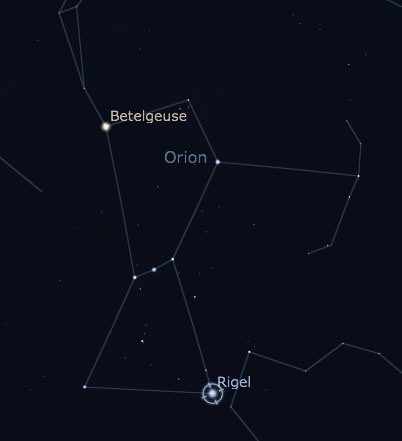Rigel
Despite it’s designation, Beta Orionis, or Rigel, is the constellations brightest star. In striking contrast to Betelgeuse, it is a brilliant blue-white color. Some have speculated that the mislabeling of the two star’s suggests Betelgeuse actually outshone Rigel in the historic past. Brilliant blue-white ‘super-giants’, such as Rigel are some of the most massive stars known. Rigel has an estimated mass of 17 Suns, a surface temperature of 11,000º C, and a luminosity 66,000 times that of our Sun. Its mass and luminosity makes is the seventh brightest star in the celestial sphere excluding the Sun and just fainter than Capella.
As scene from Earth, Rigel actually has a companion star called Rigel (B). Rigel B is itself a spectroscopic binary system, consisting of two main sequence blue-white stars of spectral type B9V that are themselves estimated to be 2.5 and 1.9 times as massive as the Sun.
Rigel should eventually expand to become a red supergiant like Betelgeuse is today and eventually explode into a spectacular super nova. It’s still a young star so its has plenty of time to shine on.

.
Rigel Overview:
- Constellation Orion
- Beta (β) 5h15m, -08°12′
- Type Main sequence star
- Magnitude 0.1
- Luminosity Suns
- Spectral Type
- Distance 780 light years
Orion Constellation … The Hunter
One of the best known constellations in the nights sky, Orion straddles the celestial equator, so that it’s visible anywhere on Earth. Representing the hunter from Greek and Roman myth, bright stars mark the shoulders (Betelgeuse & Bellatrix) and knees (Rigel & Saiph), while fainter ones trace the position of the hunter’s head, his raised shield and his club. The centerpiece of the constellation is a distinctive chain of three fairly bright stars marking the hunter’s belt. Fainter stars/nebulas make up the short chain which includes the Great Orion Nebula M42, that shows the location of his sword.
Orion is the center of a complex scene involving many of the surrounding constellations, Canis Minor and Major, directly behind him represent his hunting dogs. His foe Taurus the attacking bull that he is attempting to fend off. Lastly there is Lepus the hare that is cowering at his feet.
Astronomy 101
